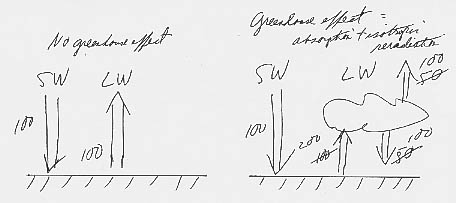
OCG123, Spring 2001
Answers to first hourly exam
Wednesday 7 February 2001, Chapters 1–3
Instructions:
Read over the entire exam first. Begin
with the questions you feel most confident about. Pace yourself so that you will
have time enough to try everything. If you don’t know how to get all the way
to an answer, go as far as you can and state how you would approach the rest.
And keep your handwriting neat! Use the back of the sheets if necessary. Show
your work so that I can give you all the partial credit you deserve.
Definitions (2 points each; 20
points total)
1. Anthropogenic—produced by humans.
2. Global warming—the recent, human
addition to the greenhouse effect.
3. Hydrosphere—the component of the
Earth system that includes all the reservoirs of water and ice on the Earth’s
surface.
4. Fossil fuels—ancient hydrocarbons
such as coal and petroleum.
5. Albedo—the fraction of incoming
radiation reflected by a surface.
6. Stable equilibrium—a state of a
system to which it returns after being disturbed.
7. Negative feedback loop—a feedback
loop that tends to diminish the effect of disturbances; contains an odd number
of couplings.
8. Long-wave radiation—radiation
emitted by the earth; in the infrared band.
9. Blackbody—a perfect absorber and
radiator (100% efficient at both).
10. H2O rotation band—a
band of wavelengths of radiation that are absorbed by a water molecule as it
passes from one rotational state (rotational energy) to a higher one.
Short answers (3 points each; 30
points total)
1. What did Keeling learn about
atmospheric CO2 from his measurements at Mauna Loa, Hawaii? That
over and above its annual cycle of 5–6 ppm, it is increasing monotonically
with time.
2. Contrast the degree to which CO2
correlates with average temperature on time scales of decades versus tens of
thousands of years. It does not correlate particularly well with temperature
on the decadal scale. On the ice-age scale it correlates much better.
3. Name three anthropogenic greenhouse
gases. Carbon dioxide, nitrous oxide, and methane.
4. What is currently the most important
greenhouse gas on earth? Water vapor.
5. Explain Wien’s law. The wavelength
of maximum radiation of a blackbody depends inversely on its absolute
temperature.
6. What has been the typical climate of
Rhode Island for the last two million years? Under two thousand feet of ice.
7. Summarize the basic Gaia hypothesis. The
Earth is a self-regulating system in which the biota play a major role.
8. Approximately what is the wavelength of
maximum radiation of the earth? 10 µm, which is in the infrared.
9. What is the difference between the
Kelvin and the Celsius scales of temperature? Temperature in kelvin units is
273 degrees higher than in degrees Celsius.
10. Given the basic stability of the
earth’s climatic system, would you most expect to find positive or negative
feedback loops in it, and why? Negative loops, because they tend to preserve
the state of the system ( to stabilize it).
Problems and longer answers (10
points each; 50 points total)
1. Describe in as much detail as you can
the typical ice-age cycle as revealed by the Vostok ice core. Use a diagram. See
page 13. You should give at least the length of a cycle, its shape, and the way
that CO2 follows the temperature.
2. Assume 100 flux units of solar
radiation being absorbed at the earth’s surface. Use a simple diagram to show
the fundamental mechanism of the greenhouse effect and how it doubles the
radiation leaving the surface.

3. Given the cross-sectional solar energy flux to earth S = 1370 W m-2, the earth’s albedo of 30%, and the Stefan-Boltzmann constant of s = 5.67 x 10-8 W m-2 K-4, derive the formula for the equilibrium temperature of the earth’s surface in the absence of a greenhouse effect, and calculate that temperature in Kelvin units.
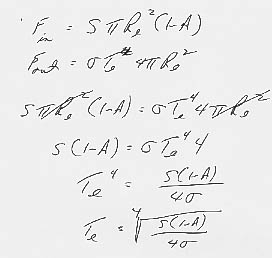
Te = 255 K
4. The snow cover of winter increases the earth’s albedo. The increased albedo reflects more of the incoming solar radiation and cools the earth. The cooler earth promotes snow rather than rain. Draw the system diagram for snow cover, albedo, and temperature of the earth. How many feedback loops are present? Are they positive or negative? Is this system inherently stable or unstable with respect to changes in temperature?
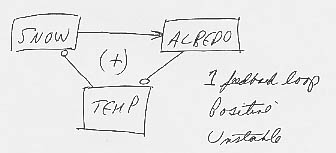
One feedback loop, which is positive. The system is unstable.
5. Daisyworld–1 and Daisyworld–2 differ only in that the white daisies in 2 grow over only one-half the range of temperatures of those in 1. Which world better resists disturbances to the daisies? Use separate diagrams of coverage vs. temperature for the two worlds to document your answer.
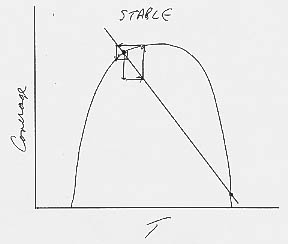
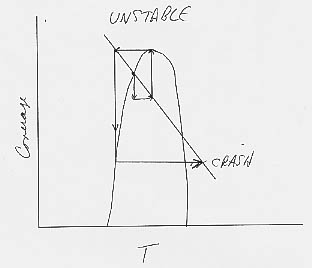
The broad system resists changes to the daisies better.